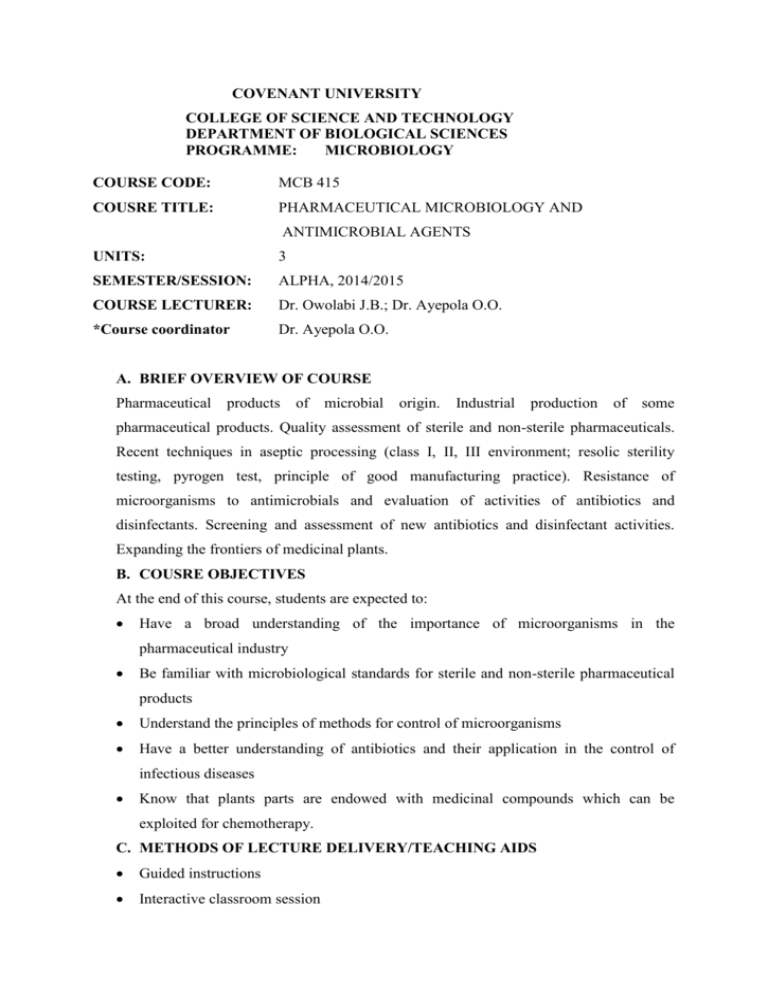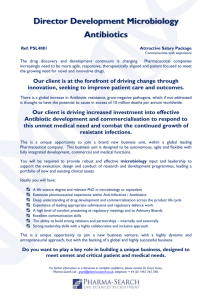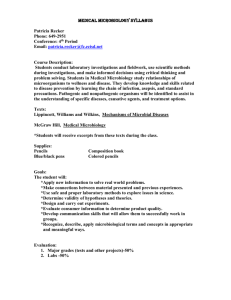covenant university college of science and
advertisement

COVENANT UNIVERSITY COLLEGE OF SCIENCE AND TECHNOLOGY DEPARTMENT OF BIOLOGICAL SCIENCES PROGRAMME: MICROBIOLOGY COURSE CODE: MCB 415 COUSRE TITLE: PHARMACEUTICAL MICROBIOLOGY AND ANTIMICROBIAL AGENTS UNITS: 3 SEMESTER/SESSION: ALPHA, 2014/2015 COURSE LECTURER: Dr. Owolabi J.B.; Dr. Ayepola O.O. *Course coordinator Dr. Ayepola O.O. A. BRIEF OVERVIEW OF COURSE Pharmaceutical products of microbial origin. Industrial production of some pharmaceutical products. Quality assessment of sterile and non-sterile pharmaceuticals. Recent techniques in aseptic processing (class I, II, III environment; resolic sterility testing, pyrogen test, principle of good manufacturing practice). Resistance of microorganisms to antimicrobials and evaluation of activities of antibiotics and disinfectants. Screening and assessment of new antibiotics and disinfectant activities. Expanding the frontiers of medicinal plants. B. COUSRE OBJECTIVES At the end of this course, students are expected to: Have a broad understanding of the importance of microorganisms in the pharmaceutical industry Be familiar with microbiological standards for sterile and non-sterile pharmaceutical products Understand the principles of methods for control of microorganisms Have a better understanding of antibiotics and their application in the control of infectious diseases Know that plants parts are endowed with medicinal compounds which can be exploited for chemotherapy. C. METHODS OF LECTURE DELIVERY/TEACHING AIDS Guided instructions Interactive classroom session Multimedia Laboratory session D. COURSE OUTLINE Module 1 Control of Microorganisms I Week 1 Definitions of terms, pattern of microbial death, conditions influencing the effectiveness of antimicrobial death activity Week 2 The use of physical agents in control First Alpha Semester Test Module 2 Control of Microorganisms II Module 3 Week 3 Use of chemical agents in control Week 4 Evaluation of antimicrobial agent effectiveness Antibiotics Week 5 Classification of antibiotics and spectrum of activity Week 6 Mechanisms of activities of antibiotics and resistance Week 7 Methods in antibiotics susceptibility testing Second Alpha Semester Test Module 4 Pharmaceutical Products of Microbial Origin Week 8 Overview and role of microorganisms in antibiotic production and other pharmaceuticals Week 9 Quality assessment of sterile and non-sterile pharmaceuticals Week 10 Techniques in aseptic processing of pharmaceutical products Week 11 Expanding the frontiers of medicinal plants Week 12 Revision and evaluation Third Alpha Semester Test E. TUTORIALS Principles of Sterilization Sterility testing Essentials of Good Manufacturing Practice (GMP) F. STRUCTURE OF THE PROGRAMME/ METHOD OF GRADING 1. Continuous Assessment and Practicals 30 Marks 2. Semester Examination 70 Marks G. GROUND RULES AND REGULATIONS Mandatory 90% class attendance No form of misbehaviour in class and laboratory Active participation in class Punctuality to classes H. TOPICS FOR TERM PAPERS/ASSIGNMENTS/STUDENTS’ ACTIVITIES 1. Development and spread of Antimicrobial Resistance 2. Expanding the frontiers of Phytomedicine I. ALIGNMENT WITH UNIVERSITY VISION AND GOALS This course provides a platform for professionalism in the Pharmaceutical Industry J. INDUSTRIAL RELEVANCE This course lays a good foundation for a career in the Pharmaceutical Industry. K. RECOMMENDED BOOKS Microbiology. Prescott LM, Harley JP, Klein DA eds. International edition; 4 th edn., McGraw Hill, New York, 1999. Pharmaceutical Microbiology WB Hugo and AD Russel (ed), 7th Edition. Blackwell Scientific Publications, UK, 2004. Medical Microbiology. Baron S. ed., 4th edn., The University of Texas Medical Branch, Galveston, 1996. Medical Microbiology and Immunology: Examination and Board Review. Levinson W, Jawetz eds. International edn., Seventh edn. Lange Medical Books/McGraw-Hill, London, 2002. District Laboratory Practice in tropical Countries Part 1. Cheesbrough M ed., Second edn. Cambridge University Press, Cambridge, 2005. District Laboratory Practice in tropical Countries Part 2. Cheesbrough M ed., Second edn. Cambridge University Press, Cambridge, 2005. Wadsworth-KTL Anaerobic Bacteriology Manual. Jousimies-Somer HR, Summanen P, Citron DM, Baron EJ, Wexler HM, Finegold SM. Sixth edn., Star Publishing Company, Belmont, California, 2002. Introduction to Diagnostic Microbiology. Koneman EW, Allen SD, Janda WM, Schreckenberger PC, Winn WC Jr. eds. JB Lippincott Company, Philadelphia, 1994. Butterworths Medical Dictionary. Critchley M. Editor-in-Chief, ELBS/Butherworths, Kent, 1986.








